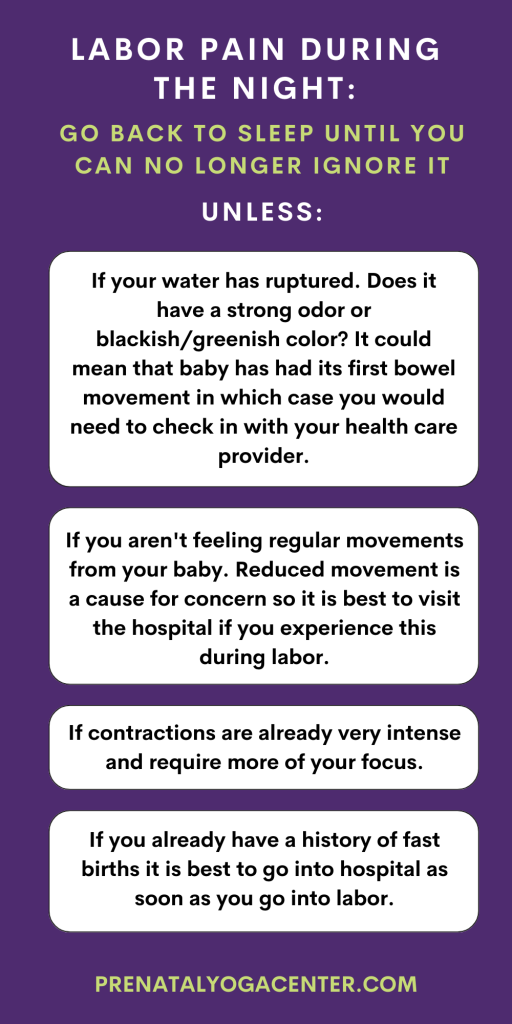Navigation
- Understanding the Early Stage of Labor
- When to Head to the Hospital
- Conserving Your Energy & Coping Skills
- When to Reconsider This Advice
- FAQs
When it comes to labor, especially for first-time parents, the journey can be long and unpredictable. One common question that arises is, “What do you do if you start to feel labor twinges in the middle of the night?” As an experienced doula, my advice is generally, “Ignore it until you can’t ignore it anymore.”
Understanding the Early Stage of Labor
The early stage of labor, which involves dilation from 0-6 cm, can take hours or even days. So, if your labor starts in the middle of the night, my advice is to go back to sleep. Preserving your energy is crucial as you don’t know how long the road ahead will be.
When to Head to the Hospital
Most hospitals prefer to see you when labor is in a steady pattern, typically using the 4-1-1 or 5-1-1 rule. This means the contractions are 4 minutes apart, lasting for a full minute, and you have been in this labor pattern for at least one hour. Heading into the hospital at your first big contraction may result in your getting sent home.
Conserving Your Energy and Coping Skills
Consider the importance of preserving your energy and avoiding frustration caused by burning through your tools and coping skills.
Years ago, when I first started attending births as a doula, my 5th client had started to feel contractions very early in the morning and asked me to come over. With my doula bag slung over my shoulder and a big cup of coffee in hand, I arrived at her apartment. I walked into the living room to find her bouncing frantically on her birth ball and every labor tool we discussed strewn around on the floor. As labor slowly crept forward, she had little interest in returning to some of the coping skills she already burned through.
If you find you are too excited to go back to sleep or perhaps too uncomfortable, consider a “Labor Project”. This could be anything that helps you keep your focus off yourself. I’ve had clients bake cookies, do prenatal yoga, organize baby clothes, or do a puzzle. When labor progresses and the cookies are now burning, you know it’s time to shift gears and get serious about having that baby!
When to Reconsider This Advice
Your water has ruptured.
Look at the color and notice the smell. If it’s a greenish/black color or has a very strong odor, that could mean that your baby passed its first bowel movement called meconium. Check in with your care provider.
Are you still feeling reassuring baby movements?
If not, please check in with your care provider.
Contractions are already very intense and require more of your focus and energy.
Then your body is telling you to get up and pay attention!
A history with fast births.
If you have had a baby already and your last one popped out in record time, staying home may not be a good idea for you. You may be in the 3% of birthers who have “precipitous” births, meaning from your first contraction, to the baby being born, was 3 hours or less.

So, for most of you, sleep, rest, and relax as you move towards the more active part of your labor. It’s just a matter of time before you meet your baby!
To book one of our prenatal yoga classes and receive more in depth knowledge about childbirth, click the link below!
FAQs
What is Prodromal Labor?
Prodromal labor is when the contractions are regular, maybe painful but not becoming longer, stronger and closer together. For many people, prodromal labor can come and go for many days. For those experiencing prodromal labor, I suggest continuing to rest, hydrate, nourish yourself and consider if your baby may be malpositioned. Check out Spinning Babies to see how you can help your baby into a more optimal birthing position.
When to start measuring contractions?
You can start timing contractions when they are becoming consistent. I have never been one to just focus on the timing of contractions but more on the physical and emotional signposts of labor.
There are many easy to use apps that can help you time contractions!
What are some comfortable positions for sleeping/resting during labor?
In early labor, you can try to side-lying with a body pillow supporting your top leg. If you happen to have a peanut ball at home and room in your bed, you can use that as well to help open the pelvic inlet!







